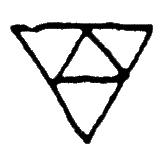THE
TRIANGLE
When
the Christians set about to develop these concepts, they began
very early on to symbolize the lateral triangle in which the area
(the spirit, God before the creation) expressed itself in the
relationship between the sides and the angles that formed the
triangle.
The idea of a triune God, that is present in all things, that
is infinite and eternal, suggests the idea that the process of
creation evolves in a kind of modular sequence. This idea adapts
itself very well to the geometric form of the triangle. It is
sufficient to multiply, each time, the central triangle, forming
another equal triangle on each face the initial triangle. In this
way we obtain a triangle that is four times the first.
They
noted that to form this figure it was necessary to draw only three
triangles.
The fourth appears from the arrangement of the other three and,
even without having its own sides, it is the central figure and
determines the size of the other triangles.
This image is very appropriate to the idea of a creative force
that exists prior to the creation of the world and that, manifesting
itself from nothing, multiplies itself infinitely, producing a
world in its own image and likeness.
To emphasize this idea, one could insert a dot in the central
triangle to indicate that it is the symbol of the holy trinity
while the other three triangles symbolize the creation of the
material universe.
But
this symbol is also a diagram that illustrates how reality can
be subdivided into the 22 simple easily identifiable categories,
of the Cabala.
| In
fact, in the three peripheral triangles in this drawing we
count 21 elements (3 sides + 3 angles + 1 area for each triangle
= 7 x 3 [the 3 external triangles] = 21). |
 |
If we add to these 21 elements another that represents the central
triangle (which, like the symbol of the holy trinity is one and
indivisible) we obtain the 22 subdivisions of the Cabala (as has
been said, the 22nd symbol was added to the Cabala with the value
of zero and we also find it in our alphabet as a Ğmuteğ letter,
a phonetic sign that allows us to indicate all of the varieties
of spoken sound that do not fit perfectly into the phonetic subdivision
of 21 sounds.
From a philosophical point of view the 22nd figure is the symbol
of all that which man is unable to capture in his attempt to represent
the world).
Besides representing in a very elegant way the Christian version
of the Cabala, this geometric diagram has another interesting
quality.
If we expanded it further with the aim of illustrating the continuing
equality of God to himself and the presence in all places of his
triune nature we obtain a design that can be read on many different
levels.
If you look at it carefully you will motive that it provokes a
small optical illusion. In fact if we look at the design a certain
way it becomes a three dimensional network of lines, or a series
of cubes of different sizes, drawn asymmetrically, that can also
appear to be hexagons; looking at it in another way we see an
infinity of rhomboids, triangles and trapezoids of various sizes
and other more unusual forms that remind us of stylized flowers
that correspond to the central triangle of the initial module
(emphasizing in this way all of the triangle that represent the
indivisible unity of the holy trinity) all of a sudden there appear
in the drawing a quantity of 6 - pointed stars and we see that
they are contained in a hexagonal cube and that they in turn contain
another hexagonal cube of smaller proportions.
In my opinion this drawing based on the triangle is very curious
because, even though it is easy to conceive, it produces a resulting
image which is very complex, just think of a prospective drawing
of a cube, which is not something that people who lived a thousand
years ago drew every day.
This
geometrical interpretation of the Christian version of the Cabala,
while it is completely faithful to the ideas presented in the
Tarots cards, is only speculation on my part. I cannot say with
any certainly that they actually made this drawing, although it
seems to me absolutely plausible that they did; on the other hand,
the fact hat, I believe around 1600, the Hebrews adopted as their
symbol the 6 pointed star
(that
we can see in the modular design which I have proposed above)
could be another indication that in fact such a geometric symbolism
was developed, as an illustration of the structure of the Cabala.